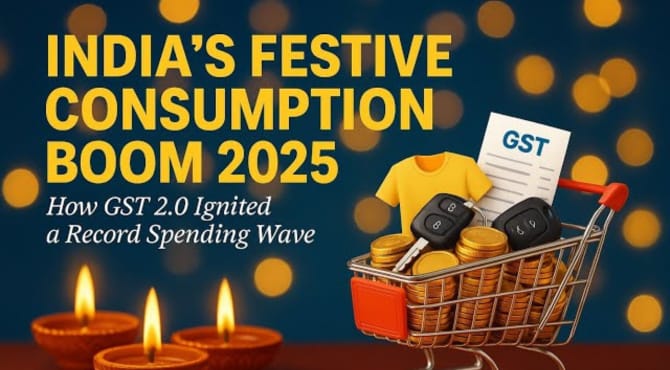India’s robust festive season spending and improved tax compliance helped the government post impressive Goods and Services Tax (GST) collections in October, signaling renewed momentum in the country’s consumption-driven economy.
The Finance Ministry announced on Saturday, November 1, that gross GST revenues touched 1.96 trillion rupees ($22.3 billion), marking a growth of about 5 percent over the same month last year. Despite recent tax cuts on several goods, net collections after refunds stood strong at 1.69 trillion rupees, a marginal increase of 0.6 percent compared with October 2024.
As India entered the festive month of October, the buzz was not restricted to shopping malls and online portals. Government coffers were ringing in cheer. Loosening purse strings over automobiles, appliances, and essentials, citizens sent consumption soaring, translating into solid indirect tax revenue growth. One of India’s most important sources of government income, the Goods and Services Tax showed resilience in the face of calibrated tax reductions on hundreds of items ranging from shampoo to cars.
This year’s figure not only indicates growing consumer confidence, but it also underlines the effectiveness of the compliance reforms that have been in place for some quarters. Collections were buoyant despite rate cuts implemented from September 22, reflecting how policy measures and economic momentum have complemented each other.
Festive spending and policy measures
October has conventionally been seen as the beginning of India’s big festival calendar, starting with Navratri, followed by Dussehra, and thereafter Diwali. Conventionally, this period sees increased spending across categories, particularly autos, electronics, and consumer goods. Retailers increase inventories while manufacturers ramp up production in anticipation of seasonal demand.
The recent government move to ease taxes was aimed at increasing this festive spending. Lower GST rates on cars, daily-use goods, and personal care items brought down prices for consumers and encouraged businesses to enlarge sales volumes. The outcome – Record footfall in stores, higher online transactions, and improved logistics movement across the country.
“Higher gross GST collections reflect strong festive seasons and higher demand,” said Abhishek Jain, partner at KPMG, “It is a positive indicator of how both consumption and compliance are moving in the right direction.” The observation reflects confidence in both the medium-term resilience of the economy and the short-term vibrancy of household spending patterns.
Economic and fiscal implications
The October figures, according to economists, reflect healthy domestic demand despite the uncertainties in the global economy and volatile commodity prices. With India retaining its status as one of the world’s fastest-growing major economies, continued GST growth supports fiscal stability and gives the government greater headroom for investments in infrastructure and welfare programs.
However, the full effect of the latest reductions would be seen only next month. Because the GST system works on a lag—collections are paid after closing of sales cycle—the November data will show whether the rate cuts resulted in any sharp revenue decline or higher consumption made up for the lower rates.
The Finance Ministry has also been emphasizing expanding the taxpayer base and curbing evasion through digital monitoring and analytics-driven compliance measures. The steady performance in collections suggests these initiatives are paying off, boosting transparency and reducing leakages in the system.
October’s GST performance paints an encouraging picture of India’s economic pulse. The blend of festive enthusiasm, strategic tax reforms, and growing consumer demand has created a virtuous cycle supporting revenue growth. Although policymakers will be watching November’s data closely to assess the delayed fiscal effects of the tax reductions, the October outcome reaffirms that India’s consumption engine remains powerful.
As the festival lights continue to shine, the GST numbers reflect optimism in the Indian economy more broadly-consumers, corporations, and the government appear to be pulling in the same direction for a stronger, more inclusive recovery.









